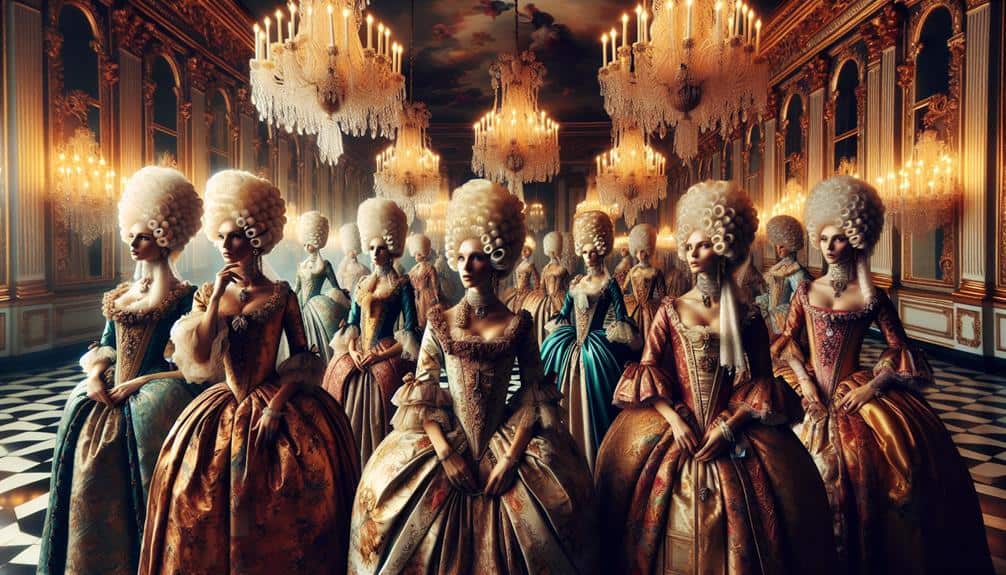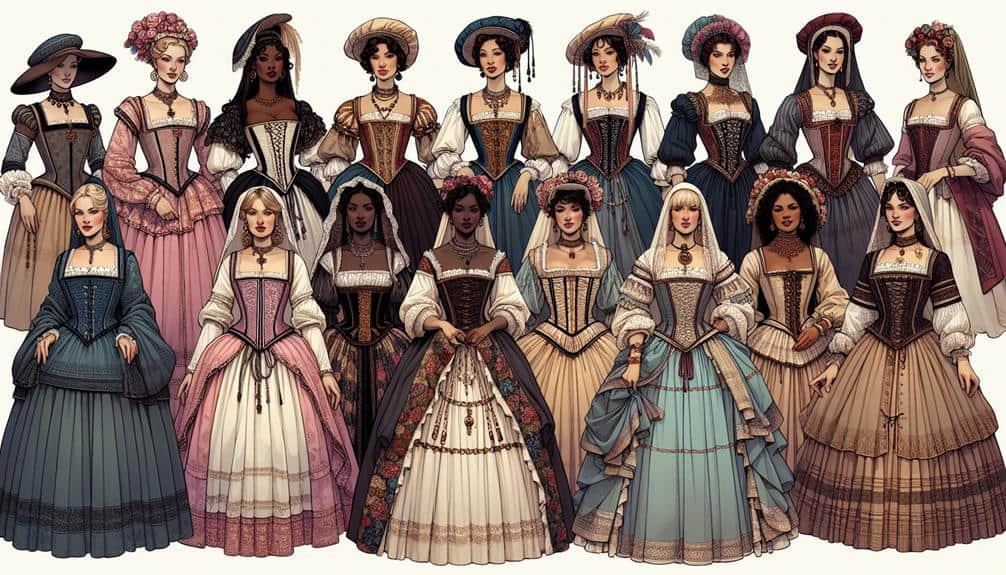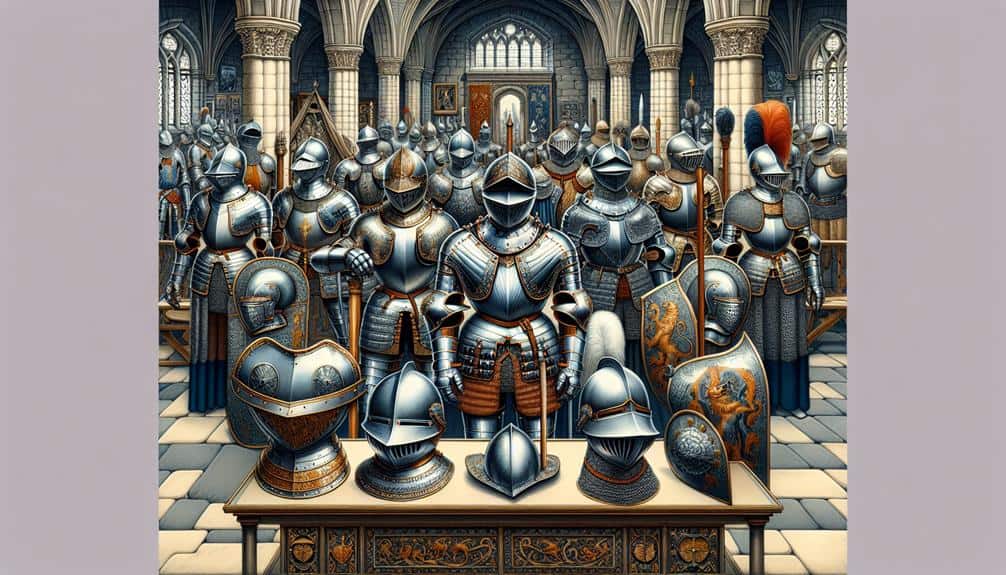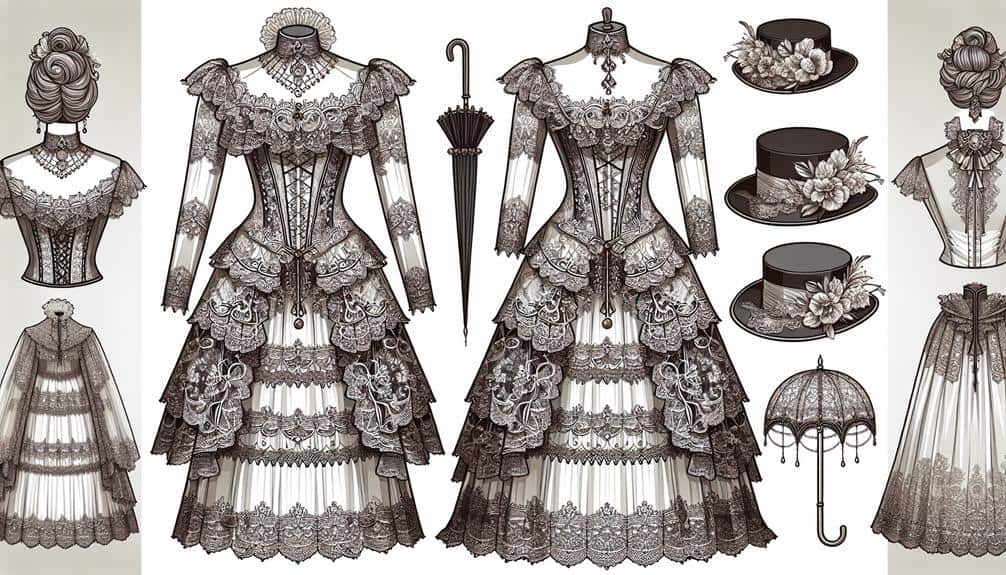If you've ever dreamed of embodying the elegance of French royalty, imagine yourself draped in the opulence of a Marie Antoinette-inspired costume. The intricate details and sumptuous fabrics of 18th-century French royal attire are more than just garments; they are a portal to a bygone era of extravagance and sophistication.
But, what sets these costumes apart? Stay tuned to discover five authentic 18th-century French royal costume ideas that will transport you back in time with style and grace.
Key Takeaways
- Channel opulence and elegance with pastel gowns, lace, and DIY techniques for Marie Antoinette inspired looks.
- Reflect grandeur with embroidered coats, silk breeches, and lavish accessories for Louis XVI royal court ensembles.
- Exude sophistication with fitted bodices, pleated back panels, and rich fabrics in jewel tones for Robe À La Française attire.
- Embody Musketeer style with wide-brimmed hats, ornate doublets, and velvet fabrics inspired by elite French Musketeers.
Marie Antoinette Inspired Costume
Channeling the opulence and elegance of the French royal court, dress yourself in a magnificent Marie Antoinette inspired costume fit for a queen. Modern interpretations of this iconic style often blend historical accuracy with contemporary flair.
To create your own Marie Antoinette ensemble, consider incorporating DIY techniques that capture the essence of this lavish era.
For a modern twist on the classic Marie Antoinette look, opt for a pastel-colored gown with intricate lace details and voluminous skirts. You can easily achieve this using simple sewing techniques and thrifted materials. Accessorize with pearl jewelry and a towering powdered wig to complete the royal aesthetic.
To add a touch of individuality to your costume, consider embellishing it with modern elements such as glittery accents or floral appliques. These small details can elevate your outfit and make it truly unique. Remember, the key to a successful Marie Antoinette inspired costume lies in the delicate balance between historical authenticity and contemporary creativity.
Louis XVI Royal Court Ensemble
To embody the grandeur of the French royal court during the reign of Marie Antoinette, consider shifting your costume inspiration to the Louis XVI Royal Court Ensemble. Louis XVI fashion trends were characterized by opulence and refinement, reflecting the extravagance of the royal court.
Historical royal attire during this period featured elaborate embroidery, luxurious fabrics like silk and velvet, and intricate lace detailing. The Louis XVI Royal Court Ensemble typically consisted of a tailored coat with ornate gold buttons, a waistcoat, breeches, and silk stockings. Accessories such as powdered wigs, elegant shoes with buckles, and lavish jewelry were essential to complete the look.
When recreating a Louis XVI-inspired costume, focus on incorporating elements that symbolize wealth and status. Opt for rich fabrics in bold colors like deep reds, blues, and greens, and don't shy away from embellishments like intricate brocade patterns and delicate lace trimmings. Pay attention to historical accuracy in silhouette and details to truly capture the essence of 18th-century French royalty in your ensemble.
Robe À La Française Attire
Embody the elegance and sophistication of French aristocratic fashion with the exquisite Robe À La Française attire. This iconic 18th-century garment epitomizes feminine elegance and historical accuracy in its design. The Robe À La Française features a fitted bodice with a flowing, pleated back panel that cascades gracefully to the floor, creating a stunning silhouette that was favored by the elite of the French royal court.
To achieve historical accuracy when donning this attire, opt for luxurious fabrics such as silk or brocade in rich jewel tones. The gown typically includes intricate embellishments like delicate lace trims, elaborate embroidery, and sumptuous ribbons that add to its opulent charm. Completing the ensemble with accessories like a feathered fan, delicate gloves, and a powdered wig will further enhance the authenticity of your look.
Whether attending a period-themed event or simply aiming to exude the grandeur of 18th-century France, embracing the Robe À La Française attire will definitely transport you back to a time of unparalleled elegance and refinement.
Musketeer Style Costume
For a mesmerizing glimpse into the world of French royal fashion, consider exploring the intricate details of a Musketeer style costume. Musketeer costumes are characterized by their flamboyant yet functional design, reflecting the attire worn by the elite French Musketeers who served as royal guards during the 17th and 18th centuries.
To achieve historical accuracy in your Musketeer ensemble, focus on key elements such as the distinctive wide-brimmed hat adorned with a plume, the ornate doublet with intricate embroidery, and the fitted breeches that allow for ease of movement during sword fighting.
When creating your Musketeer style costume, pay attention to the details that set this attire apart from other French royal garments. Opt for rich fabrics like velvet and satin in deep jewel tones, and accessorize with a rapier or épée to truly embody the spirit of a swashbuckling Musketeer.
Noblewoman's Versailles Dress
Indulge in the opulent elegance of a Noblewoman's Versailles Dress, a sartorial masterpiece that exudes luxury and sophistication reminiscent of the lavish French court of the 18th century. When recreating this aristocratic fashion, historical accuracy is key to capturing the essence of the era.
Here's how you can embody the noble aura of Versailles:
- Sumptuous Fabrics: Choose period-appropriate fabrics like silk, satin, and brocade to achieve the rich texture and sheen characteristic of noblewomen's attire.
- Intricate Embellishments: Adorn your dress with elaborate embroidery, lace, and ribbons to add a touch of opulence and detail that mirrors the extravagant tastes of the French aristocracy.
- Opulent Accessories: Complete your ensemble with opulent accessories such as feathered fans, bejeweled hairpieces, and delicate gloves to elevate your look to one befitting a noblewoman of Versailles.
- Regal Silhouette: Pay attention to the silhouette of the dress, opting for styles that feature wide panniers or structured bodices to achieve the grandeur and elegance associated with the fashion of the French royal court.
Frequently Asked Questions
What Materials Were Commonly Used in Creating 18th Century French Royal Costumes?
In creating 18th-century French royal costumes, materials like silk brocade, velvet, lace, taffeta, satin, linen, cotton, organza, damask, and wool were commonly used. These fabrics were embellished with elaborate embroidery and intricate beadwork for opulent and luxurious garments.
How Long Did It Typically Take to Create a Detailed Marie Antoinette Inspired Costume?
Crafting a Marie Antoinette-inspired costume with intricate details demands dedication. The time commitment for such historical accuracy in costume construction can range from weeks to months, depending on the complexity of design details.
Were There Any Specific Rules or Regulations Regarding the Colors That Could Be Used in Louis XVI Royal Court Ensembles?
In Louis XVI's royal court ensembles, strict rules governed colors. Historical accuracy mandates adherence to these guidelines. Restrictions assured a certain decorum and hierarchy. Understanding the regulations surrounding colors is key to creating authentic 18th-century French royal costumes.
Did Musketeers Have Any Specific Symbols or Embellishments on Their Costumes to Distinguish Them From Other Members of the Court?
As a musketeer, you would have worn distinctive insignias and embellishments on your costume to set you apart from other court members. These symbols helped showcase your role and allegiance within the royal court.
How Did the Quality and Intricacy of Noblewoman's Versailles Dresses Differ From Those of Lower Social Classes During the 18th Century?
In the 18th century, noblewomen's attire at Versailles showcased opulence, intricate designs, and luxurious fabrics, reflecting their high social status. In contrast, lower classes had simpler, less ornate clothing, highlighting the stark disparities in fashion influenced by social hierarchy.



